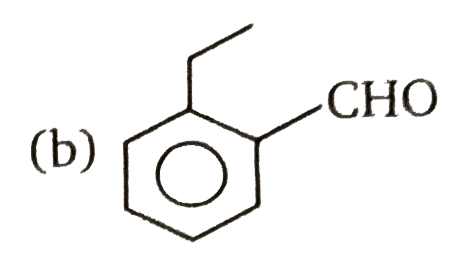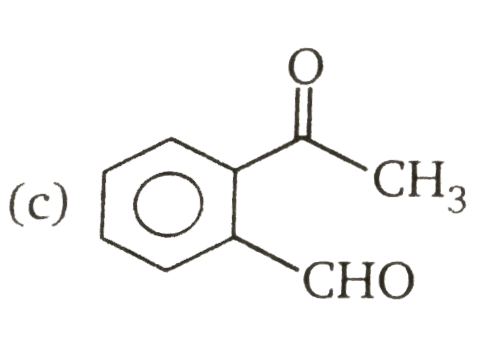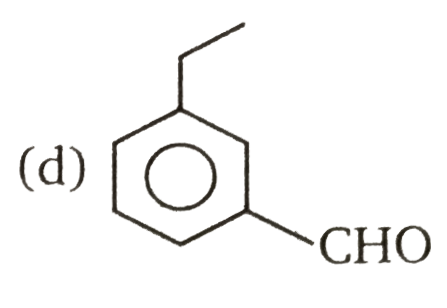An organic compound with molecular formula C9H10O forms 2,4,-DNP derivative reduces Tollen's reagent and undergoes Cannizzaro reaction .On vigorous oxidation it gives 1,4-benzene dicarboxylic acid Identify the compound .
To identify the organic compound with the molecular formula C9H10O, we can analyze the information provided step by step.
Step 1: Analyze the Molecular Formula
The molecular formula C9H10O indicates that the compound contains 9 carbon atoms, 10 hydrogen atoms, and 1 oxygen atom.
Hint: Look for functional groups that can fit this molecular formula, particularly those that contain carbonyl groups (C=O).
Step 2: Identify the Functional Groups
The compound forms a 2,4-DNP derivative, which indicates that it is a carbonyl compound (either an aldehyde or a ketone). Since it reduces Tollen's reagent, it must be an aldehyde, as ketones do not reduce Tollen's reagent.
Hint: Remember that Tollen's reagent is used to distinguish between aldehydes and ketones; only aldehydes can reduce it.
Step 3: Cannizzaro Reaction
The compound undergoes a Cannizzaro reaction, which occurs in aldehydes that lack an alpha hydrogen atom. This means that the aldehyde must be aromatic and not have any hydrogen atoms on the carbon adjacent to the carbonyl group.
Hint: Identify aldehydes that are aromatic and lack alpha hydrogens.
Step 4: Oxidation Product
The compound, upon vigorous oxidation, yields 1,4-benzene dicarboxylic acid. This suggests that the compound must have a structure that, when oxidized, can produce two carboxylic acid groups at the para positions on a benzene ring.
Hint: Consider the structure of 1,4-benzene dicarboxylic acid (also known as phthalic acid) and how it can be formed from an aldehyde.
Step 5: Construct the Structure
Given that the compound is an aromatic aldehyde with no alpha hydrogen, we can deduce that it is para-substituted. The most logical structure that fits all the criteria is para-ethylbenzaldehyde (4-ethylbenzaldehyde). This compound has:
- A benzene ring (6 carbons)
- An aldehyde group (-CHO)
- An ethyl group (-C2H5) attached to the para position of the benzene ring.
The total number of carbons is 6 (from the benzene) + 2 (from the ethyl group) + 1 (from the aldehyde) = 9, which matches the molecular formula C9H10O.
Hint: Verify that the total number of carbons, hydrogens, and the functional groups match the given molecular formula.
Conclusion
The compound is identified as para-ethylbenzaldehyde (4-ethylbenzaldehyde).
The molecular formula C9H10O indicates that the compound contains 9 carbon atoms, 10 hydrogen atoms, and 1 oxygen atom.
The compound forms a 2,4-DNP derivative, which indicates that it is a carbonyl compound (either an aldehyde or a ketone). Since it reduces Tollen's reagent, it must be an aldehyde, as ketones do not reduce Tollen's reagent.
The compound undergoes a Cannizzaro reaction, which occurs in aldehydes that lack an alpha hydrogen atom. This means that the aldehyde must be aromatic and not have any hydrogen atoms on the carbon adjacent to the carbonyl group.
The compound, upon vigorous oxidation, yields 1,4-benzene dicarboxylic acid. This suggests that the compound must have a structure that, when oxidized, can produce two carboxylic acid groups at the para positions on a benzene ring.
Given that the compound is an aromatic aldehyde with no alpha hydrogen, we can deduce that it is para-substituted. The most logical structure that fits all the criteria is para-ethylbenzaldehyde (4-ethylbenzaldehyde). This compound has:
- A benzene ring (6 carbons)
- An aldehyde group (-CHO)
- An ethyl group (-C2H5) attached to the para position of the benzene ring.
The compound is identified as para-ethylbenzaldehyde (4-ethylbenzaldehyde).
Topper's Solved these Questions
- ALDEHYDES ,KETONES AND CARBOXYLIC ACIDSBOOK - MODERN PUBLICATIONCHAPTER - ALDEHYDES ,KETONES AND CARBOXYLIC ACIDSEXERCISE - Conceptula Questions 2
15 Videos
- ALDEHYDES ,KETONES AND CARBOXYLIC ACIDSBOOK - MODERN PUBLICATIONCHAPTER - ALDEHYDES ,KETONES AND CARBOXYLIC ACIDSEXERCISE - NCERT FILE (NCERT IN TEXT QUESTIONS )
8 Videos
- ALDEHYDES ,KETONES AND CARBOXYLIC ACIDSBOOK - MODERN PUBLICATIONCHAPTER - ALDEHYDES ,KETONES AND CARBOXYLIC ACIDSEXERCISE - PRACTICE PROBLEMS
30 Videos
- ALCOHOLS, PHENOLS AND ETHERSBOOK - MODERN PUBLICATIONCHAPTER - ALCOHOLS, PHENOLS AND ETHERSEXERCISE - UNIT PRACTICE TEST (FOR BOARD EXAMINATION)
12 Videos
- BIOMOLECULESBOOK - MODERN PUBLICATIONCHAPTER - BIOMOLECULESEXERCISE - UNIT PRACTICE TEST FOR BOARD EXAMINATION
13 Videos
Similar Questions
(a) Write a suitable chemicals equation to complete each of the following transformations :
(i) Butan-1-o1 to butanoic acid
(ii) 4-Methylacetophenone to benzene-1,4-dicarboxylic acid
(b) An organic compound with molecular formula C9H10O froms 2-4-DNP derivative , reduces Tollen's reagent and undergoes Cannizzaro's reaction . On vigorous oxidation it gives 1,2-benzenedicarboxylic acid , Identify the compound .
View Solution(a) Give a plausible expianation for each one of the following : -
(i) There are two - NH2 groupsin semicarbazide. However, only one such group is involvedin the formation of semicarbazones.
(ii) Cyclohexanone forms cyanohydrin in good yield but 2,4,6-trimethylcyclohexanone does not.
(b) An organic compound with molecular formulaC9H10O forms, 2,4- DNP derivative, reduces Tollens' reagent and undergoes Cannizzaro reaction.
On vigorous oxidation it gives 1,2-benzene-di-carboxylic acid. Identify the compound.
View Solution
Knowledge Check
An organic compound with the molecular formula, C8H8O forms, 2,4-DNP derivative, reduces Tollens' reagent and udergoes Cnnizzron reaction. On vigorous oxidation it gives 1,2-benzene di-carboxylic acid. The organic compound is :
A2-ethylbenzaldehydeB2-methylbenzaldehydeCacetophenoneD3-methylbenzaldehydeAn organic compound with the molecular formula, C8H8O forms, 2,4-DNP derivative, reduces Tollens' reagent and udergoes Cnnizzron reaction. On vigorous oxidation it gives 1,2-benzene di-carboxylic acid. The organic compound is :
A2-methylbenzaldehydeB2-ethylbenzaldehydeC3-methylbenzaldehydeDphenylacetaldehydeAn organic commpound with the jmolecular formula C9H10O forms a 2,4-DNP derivative, reduces tollen's reagent and undergoes cannizaro reaction, on vigorous oxidation it gives 1,2-benzenedicarboxylic acid. Structure of organic compound is:
A B
B C
C D
D
(a) An organic compound with the molecular formula C9H10O forms 2, 4-DNP derivative, reduces Tollen's reagent and undergoes Cannizzaro reaction. On vigorous oxidation, it gives 1,2-benzenedicarboxylic acid. Identify the compound.
(B ) Arrange the following compounds in the increasing order of their reactivity in nucleophilic addition reaction : Ethanal, propanal, propanone, butanone.
(c) Although p-hydroxybenzoic acid is less acidic than benzoic acid, ortho hydroxybenzoic acid is about 15 times more acidic than benzoic acid. Explain.
View SolutionAn organic compound with the molecular formula C9H10O forms 2, 4 - DNP derivative, reduces Tollens' reagent and undergoes Cannizzaro reaction. On vigorous oxidation, it gives 1, 2 - benzenedicarboxylic acid. Identify the compound.
View SolutionAn organic compound with the molecular folmula C9H10O form 2,4-DNP derivative, reduces Tollens reagent, and undergoes Cannizaro reaction. On vigorous oxidation, it gives 1,2-benzenedicarboxylic acid. Identify the compound.
View SolutionAn organic compound with the molecular folmula C9H10O form 2,4-DNP derivative, reduces Tollens reagent, and undergoes Cannizaro reaction. On vigorous oxidation, it gives 1,2-benzenedicarboxylic acid. Identify the compound.
View SolutionAn organic compound with undergoes formula C9H10O forms 2,4-DNP derivattive, reduces Tollen's reagent ad undergoes Cannizzaro's reaction. On vigorous oxidation it gives 1,2-benzendicarboxylic acid. Identify the compound.
View Solution
